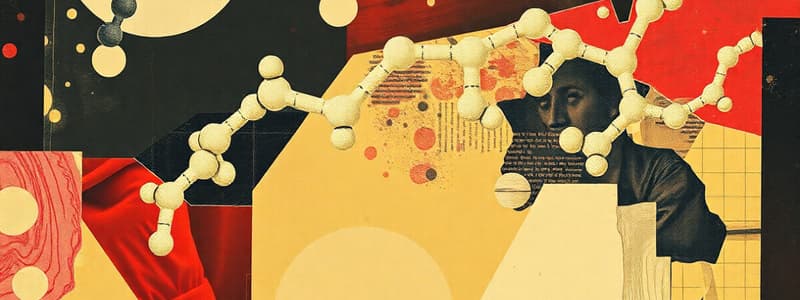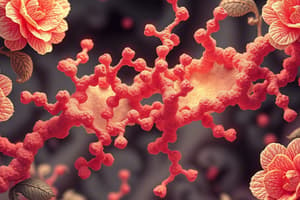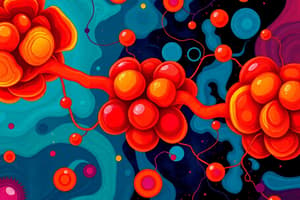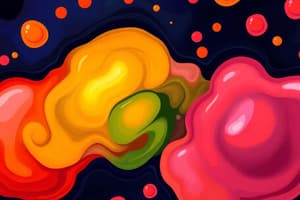Podcast
Questions and Answers
What is the primary role of hemoglobin in the blood?
What is the primary role of hemoglobin in the blood?
- Storing nutrients for energy
- Transporting gases, particularly oxygen (correct)
- Transporting carbon dioxide from the lungs
- Transporting hormones throughout the body
Which of the following statements about hemoglobin's structure is true?
Which of the following statements about hemoglobin's structure is true?
- It consists of four identical polypeptide chains
- It has a quaternary structure with four polypeptide chains (correct)
- It has a linear structure made of amino acids
- It is a monomeric protein with no subunits
What happens to hemoglobin when it binds with oxygen?
What happens to hemoglobin when it binds with oxygen?
- It undergoes a transition from T state to R state (correct)
- It destabilizes its iron centers
- It remains in the same T state
- It loses its allosteric properties
How do protons and CO2 affect hemoglobin's affinity for oxygen?
How do protons and CO2 affect hemoglobin's affinity for oxygen?
What is meant by hemoglobin being an allosteric protein?
What is meant by hemoglobin being an allosteric protein?
What is the main physiological role of 2,3-bisphosphoglycerate (BPG) in hemoglobin?
What is the main physiological role of 2,3-bisphosphoglycerate (BPG) in hemoglobin?
Which amino acid residues are most commonly found in collagen structure?
Which amino acid residues are most commonly found in collagen structure?
What type of structural feature is characteristic of collagen?
What type of structural feature is characteristic of collagen?
What impact do cross-links have on collagen fibers?
What impact do cross-links have on collagen fibers?
Which type of collagen is primarily responsible for providing resistance to tension?
Which type of collagen is primarily responsible for providing resistance to tension?
What is a feature of fibrous proteins that contributes to their structural function?
What is a feature of fibrous proteins that contributes to their structural function?
Which statement best describes the formation of tropocollagen?
Which statement best describes the formation of tropocollagen?
What role does 2,3-bisphosphoglycerate (BPG) play at high altitudes?
What role does 2,3-bisphosphoglycerate (BPG) play at high altitudes?
What is a common name for osteogenesis imperfecta?
What is a common name for osteogenesis imperfecta?
What substance is primarily deficient in scurvy, leading to collagen issues?
What substance is primarily deficient in scurvy, leading to collagen issues?
What type of collagen does osteogenesis imperfecta primarily affect?
What type of collagen does osteogenesis imperfecta primarily affect?
Which statement correctly describes myosin?
Which statement correctly describes myosin?
What characterizes the thick filaments in myosin?
What characterizes the thick filaments in myosin?
What is the structure of G-actin?
What is the structure of G-actin?
Which of the following best describes the structure of F-actin?
Which of the following best describes the structure of F-actin?
What physical property is associated with the carboxyl terminus of myosin?
What physical property is associated with the carboxyl terminus of myosin?
What is a key characteristic that distinguishes globular proteins from fibrous proteins?
What is a key characteristic that distinguishes globular proteins from fibrous proteins?
What is the main function of myoglobin in muscle tissue?
What is the main function of myoglobin in muscle tissue?
Which structural feature is unique to hemoglobin compared to myoglobin?
Which structural feature is unique to hemoglobin compared to myoglobin?
Which amino acid residue plays a crucial role in coordinating the iron atom within the heme group of myoglobin?
Which amino acid residue plays a crucial role in coordinating the iron atom within the heme group of myoglobin?
How does the heme group protect iron from oxidation in globular proteins?
How does the heme group protect iron from oxidation in globular proteins?
What is the primary function of hemoglobin in the erythrocytes?
What is the primary function of hemoglobin in the erythrocytes?
What type of structural arrangement do myoglobin and hemoglobin both share regarding their heme groups?
What type of structural arrangement do myoglobin and hemoglobin both share regarding their heme groups?
What is the role of prosthetic groups in conjugated proteins like hemoglobin?
What is the role of prosthetic groups in conjugated proteins like hemoglobin?
Flashcards
Distal His
Distal His
A histidine close to the heme but not bound, favoring oxygen entry over CO.
Oligomeric protein
Oligomeric protein
A protein with multiple polypeptide chains, like hemoglobin with quaternary structure.
T state
T state
The tense state of hemoglobin, lacking oxygen, where binding sites are less available.
R state
R state
Signup and view all the flashcards
Allosteric protein
Allosteric protein
Signup and view all the flashcards
Elastic Cartilage
Elastic Cartilage
Signup and view all the flashcards
Types of Collagen Disorders
Types of Collagen Disorders
Signup and view all the flashcards
Osteogenesis Imperfecta
Osteogenesis Imperfecta
Signup and view all the flashcards
Scurvy
Scurvy
Signup and view all the flashcards
Myosin Structure
Myosin Structure
Signup and view all the flashcards
Thick Filaments
Thick Filaments
Signup and view all the flashcards
G-actin vs F-actin
G-actin vs F-actin
Signup and view all the flashcards
Function of Actin
Function of Actin
Signup and view all the flashcards
Globular proteins
Globular proteins
Signup and view all the flashcards
Myoglobin
Myoglobin
Signup and view all the flashcards
Hemoglobin
Hemoglobin
Signup and view all the flashcards
Prosthetic group
Prosthetic group
Signup and view all the flashcards
Heme group
Heme group
Signup and view all the flashcards
Apoprotein
Apoprotein
Signup and view all the flashcards
Quaternary structure
Quaternary structure
Signup and view all the flashcards
Tertiary structure
Tertiary structure
Signup and view all the flashcards
CO2 and Hemoglobin
CO2 and Hemoglobin
Signup and view all the flashcards
2,3-bisphosphoglycerate (BPG)
2,3-bisphosphoglycerate (BPG)
Signup and view all the flashcards
Fibrous Proteins
Fibrous Proteins
Signup and view all the flashcards
Collagen
Collagen
Signup and view all the flashcards
Collagen Helix Structure
Collagen Helix Structure
Signup and view all the flashcards
Tropocollagen
Tropocollagen
Signup and view all the flashcards
Cross-linking in Collagen
Cross-linking in Collagen
Signup and view all the flashcards
Types of Collagen
Types of Collagen
Signup and view all the flashcards
Study Notes
Structure-Function Relationship in Specific Proteins
- Globular proteins exhibit a compact, rounded shape, making them water-soluble. These proteins are crucial in diverse biological processes, including enzyme activity, transport, and regulation. Examples include hemoglobin and myoglobin.
- Fibrous proteins are insoluble in water. Their hydrophobic amino acid residues concentrate on the interior and surface, lending strength and flexibility to their structures. They form elaborate supramolecular complexes. Examples include collagen, myosin, and actin fibers.
Globular Proteins: Hemoglobin and Myoglobin
- Hemoglobin is an oligomeric protein (quaternary structure) whose function is to transport gases in the blood. It contains 4 polypeptide chains and 4 heme prosthetic groups, including 2 alpha and 2 beta subunits. Subunits are arranged symmetrically with non-covalent interactions.
- Myoglobin is a monomeric protein. It stores oxygen within muscle tissue for times of intense respiration. Myoglobin's role is different from hemoglobin as it releases oxygen upon lower oxygen pressures. Both hemoglobin and myoglobin are conjugated proteins with an associated heme prosthetic group that contains iron in the ferrous state (Fe2+).
Globular Proteins: Heme Group Structure
- The heme group's complex organic ring structure is porphyrin.
- The iron atom in heme has 6 coordination bonds: 4 in the plane of the porphyrin ring system, and 2 perpendicular to it.
- The proximal histidine residue coordinates with the iron (perpendicular direction); the distal histidine residue is near the iron (but not directly bonded), and is important to regulate oxygen binding and preventing carbon monoxide binding.
- Iron is protected from oxidation within a hydrophobic pocket of the apoprotein. This pocket also prevents CO from binding.
Agents Affecting Oxygen Binding in Hemoglobin
- Protons (H⁺) and carbon dioxide (CO2), waste products from cellular respiration, lower hemoglobin's affinity for oxygen as both molecules are released to tissues.
- 2,3-bisphosphoglycerate (BPG) is an important physiological adaptation to high altitude. Decreased affinity for oxygen, increasing oxygen release to tissues.
Allosteric Properties
- Allosteric proteins, like hemoglobin, typically have multiple subunits with multiple ligand-binding sites, enabling a change in conformation when a ligand binds at one site. This affects ligand binding at another site.
- The binding of the first oxygen molecule to hemoglobin shifts the structure leading to enhanced oxygen binding to the other subunits in the molecule. This facilitates an effective transport mechanism of oxygen.
Fibrous Proteins: Collagen
- Collagen is insoluble in water, comprised of primarily glycine, proline, and hydroxyproline amino acids. Its secondary structure is a left-handed helix.
- Its triple helix of polypeptide chains forms tropocollagen. Tropocollagen molecules aggregate to form collagen fibers that provide strength to various connective tissues, such as tendons, cartilage, bone, and the cornea of the eye.
- Cross-linking of collagen fibers, facilitated by covalent bonds, increases with age, making tissues more rigid.
Fibrous Proteins: Myosin
- Myosin is a six-subunit protein containing two heavy chains and two light chains.
- Its carboxyl terminus is associated with a region of extended alpha-helix structure and a left-handed supercoiled helix. A globular domain contains the site where ATP is hydrolyzed.
- The light chains are associated with the globular domains. Myosin is a key component in muscle contraction, thick filaments, which are composed of multiple myosin molecules.
Fibrous Proteins: Actin
- Actin is a monomeric (G-actin) protein that polymerizes into a filamentous (F-actin) structure, which is right-handed.
- Thin filaments are composed of F-actin, troponin, and tropomyosin. Each actin monomer tightly binds to a myosin head group, which is a key element in muscle contraction and regulation.
Fibrous Proteins: Collagen Types
- Different collagen types (at least 27) have different tissue distributions and functions based on their structural differences, particularly the degree and presence of covalent cross-links.
- Various collagen types support the structure and function in numerous tissues, ensuring flexibility, structure, and resistance to stress.
Diseases Associated with Collagen
- Osteogenesis imperfecta is a genetically-based disorder characterized by brittle bones prone to fractures.
- Scurvy, caused by a lack of vitamin C, affects the proper formation of hydroxyproline in collagen, affecting the stability of the triple helix structure and leading to a variety of connective tissue disorders.
Studying That Suits You
Use AI to generate personalized quizzes and flashcards to suit your learning preferences.




